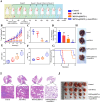Light-triggered multifunctional nanoplatform for efficient cancer photo-immunotherapy
- PMID: 35392911
- PMCID: PMC8991811
- DOI: 10.1186/s12951-022-01388-8
Light-triggered multifunctional nanoplatform for efficient cancer photo-immunotherapy
Erratum in
-
Correction to: Light-triggered multifunctional nanoplatform for efficient cancer photo-immunotherapy.J Nanobiotechnology. 2025 Jul 16;23(1):517. doi: 10.1186/s12951-025-03584-8. J Nanobiotechnology. 2025. PMID: 40665322 Free PMC article. No abstract available.
Abstract
Cancer immunotherapy is limited by the immune escape of tumor cells and adverse effects. Photo-immunotherapy, the combination of immunotherapy and phototherapy (such as photodynamic therapy (PDT) and photothermal therapy (PTT)), can improve the effectiveness of immunotherapy in cancer treatment. Here, we first explored mesoporous hexagonal core-shell zinc porphyrin-silica nanoparticles (MPSNs), which are composed of a zinc porphyrin core and a mesoporous silica shell, and exhibit high laser-triggered photodynamic and photothermal activity, as well as outstanding drug loading capacity. In other words, MPSNs can be used not only as excellent photosensitizers for photo-immunotherapy, but also as an ideal drug carrier to achieve more efficient synergy. After loading with R837 (imiquimod, a toll-like receptor-7 agonist), MPSNs@R837 will elicit high-efficiency immunogenic cell death via PDT and PTT, and promote dendritic cell maturation after the PH-responsive release of R837, thereby, inducing tumor-specific immune responses. When combined with a programmed death ligand-1 checkpoint blockade, the photo-immunotherapy system markedly restrains primary tumors and metastatic tumors with negligible systemic toxicity. Therefore, the therapeutic strategy of integrating PTT, PDT and checkpoint blockade, shows great potential for suppressing cancer metastasis.
Keywords: Dendritic cell; Hexahedron zinc porphyrin mesoporous nanoparticles; Immune response; PD-L1 checkpoint blockade; Photo-immunotherapy.
© 2022. The Author(s).
Conflict of interest statement
The authors declare no conflict of interest.
Figures










Similar articles
-
Oncolytic reovirus enhances the effect of CEA immunotherapy when combined with PD1-PDL1 inhibitor in a colorectal cancer model.Immunotherapy. 2025 Apr;17(6):425-435. doi: 10.1080/1750743X.2025.2501926. Epub 2025 May 12. Immunotherapy. 2025. PMID: 40353308
-
Combined Photothermal Therapy and Cancer Immunotherapy by Immunogenic Hollow Mesoporous Silicon-Shelled Gold Nanorods.J Pharm Sci. 2024 Aug;113(8):2232-2244. doi: 10.1016/j.xphs.2024.03.007. Epub 2024 Mar 16. J Pharm Sci. 2024. PMID: 38492845
-
Biodegradable oxygen-producing manganese-chelated metal organic frameworks for tumor-targeted synergistic chemo/photothermal/ photodynamic therapy.Acta Biomater. 2022 Jan 15;138:463-477. doi: 10.1016/j.actbio.2021.10.032. Epub 2021 Oct 27. Acta Biomater. 2022. PMID: 34718179
-
Composite Nanomaterials of Conjugated Polymers and Upconversion Nanoparticles for NIR-Triggered Photodynamic/Photothermal Synergistic Cancer Therapy.ACS Appl Mater Interfaces. 2024 Apr 24;16(16):19926-19936. doi: 10.1021/acsami.3c12553. Epub 2023 Nov 17. ACS Appl Mater Interfaces. 2024. PMID: 37975246 Review.
-
Interventions for cutaneous Bowen's disease.Cochrane Database Syst Rev. 2013 Jun 24;2013(6):CD007281. doi: 10.1002/14651858.CD007281.pub2. Cochrane Database Syst Rev. 2013. PMID: 23794286 Free PMC article.
Cited by
-
Multifunctional mesoporous silica nanoparticles for biomedical applications.Signal Transduct Target Ther. 2023 Nov 24;8(1):435. doi: 10.1038/s41392-023-01654-7. Signal Transduct Target Ther. 2023. PMID: 37996406 Free PMC article. Review.
-
Immune modulations of the tumor microenvironment in response to phototherapy.J Innov Opt Health Sci. 2023 May;16(3):2330007. doi: 10.1142/s1793545823300070. Epub 2023 Apr 27. J Innov Opt Health Sci. 2023. PMID: 38550850 Free PMC article.
-
Biometallic ions and derivatives: a new direction for cancer immunotherapy.Mol Cancer. 2025 Jan 15;24(1):17. doi: 10.1186/s12943-025-02225-w. Mol Cancer. 2025. PMID: 39815289 Free PMC article. Review.
-
Mesoporous Nanoparticles for Diagnosis and Treatment of Liver Cancer in the Era of Precise Medicine.Pharmaceutics. 2022 Aug 23;14(9):1760. doi: 10.3390/pharmaceutics14091760. Pharmaceutics. 2022. PMID: 36145508 Free PMC article. Review.
-
A Review of the Efficacy of Nanomaterial-Based Natural Photosensitizers to Overcome Multidrug Resistance in Cancer.Pharmaceutics. 2024 Aug 24;16(9):1120. doi: 10.3390/pharmaceutics16091120. Pharmaceutics. 2024. PMID: 39339158 Free PMC article. Review.
References
-
- Meng Z, Zhou X, Xu J, Han X, Dong Z, Wang H, Zhang Y, She J, Xu L, Wang C, Liu Z. Light-triggered in situ gelation to enable robust photodynamic-immunotherapy by repeated stimulations. Adv Mater. 2019;31:e1900927. - PubMed
-
- Chen Q, Chen J, Yang Z, Xu J, Xu L, Liang C, Han X, Liu Z. Nanoparticle-enhanced radiotherapy to trigger robust cancer immunotherapy. Adv Mater. 2019;31:e1802228. - PubMed
-
- Gao S, Li T, Guo Y, Sun C, Xianyu B, Xu H. Selenium-Containing Nanoparticles Combine the NK Cells Mediated Immunotherapy with Radiotherapy and Chemotherapy. Adv Mater. 2020;32:e1907568. - PubMed
-
- Chang M, Wang M, Wang M, Shu M, Ding B, Li C, Pang M, Cui S, Hou Z, Lin J. a multifunctional cascade bioreactor based on hollow-structured Cu2 MoS4 for synergetic cancer chemo-dynamic therapy/starvation therapy/phototherapy/immunotherapy with remarkably enhanced efficacy. Adv Mater. 2019;31:e1905271. - PubMed
MeSH terms
Substances
Grants and funding
LinkOut - more resources
Full Text Sources
Medical
Research Materials

